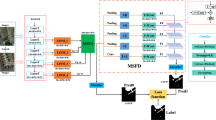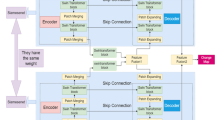Abstract
Remote sensing image change detection is an important technology in remote sensing data analysis. Existing mainstream solutions are divided into supervised and unsupervised solutions. Among supervised methods, most remote sensing image change methods based on deep learning are related to semantic segmentation. However, these methods only use deep learning model to extract and process single-level information of the image, and do not separately train the changed and unchanged areas according to the task characteristics of change detection. Also this model do not aggregate the deep and shallow-level feature information, so many local change details cannot be detected. This paper proposes a multilateral feature-guided aggregation network. The network firstly extracts the whole information, the changed area information and the unchanged area information of remote sensing image through the main network and two auxiliary networks: difference network and assimilation network. Then, the whole information of the image is aggregated with the changed and unchanged region information by feature aggregation network (all subnetworks are composed of convolutional neural networks (CNNs)). The proposed method is end-to-end trainable, and each component in the network does not need to be trained separately.















Similar content being viewed by others
References
Tison C, Nicolas J-M, Tupin F, Maître H (2004) A new statistical model for Markovian classification of urban areas in high-resolution SAR images. IEEE Trans Geosci Remote Sens 42(10):2046–2057
Sommer S, Hill J, Megier J (1998) The potential of remote sensing for monitoring rural land use changes and their effects on soil conditions. Agric Ecosyst Environ 67(2–3):197–209
Fichera CR, Modica G, Pollino M (2012) Land cover classification and change-detection analysis using multi-temporal remote sensed imagery and landscape metrics. Eur J Remote Sens 45(1):1–18
Gillespie TW, Chu J, Frankenberg E, Thomas D (2007) Assessment and prediction of natural hazards from satellite imagery. Prog Phys Geogr 31(5):459–470
Dong L, Shan J (2013) A comprehensive review of earthquake-induced building damage detection with remote sensing techniques. ISPRS J of Photogramm Remote Sens 84:85–99
Keim Daniel A (2000) Designing pixel-oriented visualization techniques: theory and applications. IEEE Trans Vis Comput Graph 6(1):59–78
Coad P, Yourdon E (1991) Object oriented analysis
Blasco J, Aleixos N, Moltó E (2007) Computer vision detection of peel defects in citrus by means of a region oriented segmentation algorithm. J Food Eng 81(3):535–543
Bovolo F, Bruzzone L, Solano-Correa YT (2017) Multitemporal analysis of remotely sensed image data
Saha S, Solano-Correa YT, Bovolo F, Bruzzone L (2020) Unsupervised deep transfer learning-based change detection for HR multispectral images. IEEE Geosci Remote Sens Lett 18:856–860
Peng D, Zhang Y, Guan H (2019) End-to-end change detection for high resolution satellite images using improved UNet++. Remote Sens 11(11):1382
Ball JE, Anderson DT, Chan CS Sr (2017) Comprehensive survey of deep learning in remote sensing: theories, tools, and challenges for the community. J Appl Remote Sens 11(4):042609
Nielsen AA, Conradsen K, Simpson JJ (1998) Multivariate alteration detection (MAD) and MAF postprocessing in multispectral, bitemporal image data: new approaches to change detection studies. Remote Sens Environ 64(1):1–19
Nielsen AA (2007) The regularized iteratively reweighted mad method for change detection in multi-and hyperspectral data. IEEE Trans Image Process 16(2):463–478
Zhang H, Gong M, Zhang P, Su L, Shi J (2016) Feature-level change detection using deep representation and feature change analysis for multispectral imagery. IEEE Geosci Remote Sens Lett 13(11):1666–1670
Malila William A (1980) Change vector analysis: an approach for detecting forest changes with landsat. In: LARS symposia, p 385
Sesnie SE, Gessler PE, Finegan B, Thessler S (2008) Integrating landsat TM and SRTM-DEM derived variables with decision trees for habitat classification and change detection in complex neotropical environments. Remote Sens Environ 112(5):2145–2159
Chen B, Xia M, Huang J (2021) Mfanet: a multi-level feature aggregation network for semantic segmentation of land cover. Remote Sens 13(4):731
Xia M, Wang T, Zhang Y, Liu J, Xu Y (2021) Cloud/shadow segmentation based on global attention feature fusion residual network for remote sensing imagery. Int J Remote Sens 42(6):2022–2045
Xia M, Cui Y, Zhang Y, Xu Y, Liu J, Xu Y (2021) DAU-Net: a novel water areas segmentation structure for remote sensing image. Int J Remote Sens 42(7):2594–2621
Xia M, Wang K, Song W, Chen C, Li Y et al (2020) Non-intrusive load disaggregation based on composite deep long short-term memory network. Expert Syst Appl 160:113669
Gong M, Zhao J, Liu J, Miao Q, Jiao L (2015) Change detection in synthetic aperture radar images based on deep neural networks. IEEE Trans Neural Netw Learn Syst 27(1):125–138
Zhan Y, Fu K, Yan M, Sun X, Wang H, Qiu X (2017) Change detection based on deep siamese convolutional network for optical aerial images. IEEE Geosci Remote Sens Lett 14(10):1845–1849
Al-Huda Z, Peng B, Yang Y, Algburi RN, Ahmad M, Khurshid F, Moghalles K (2021) Weakly supervised semantic segmentation by iteratively refining optimal segmentation with deep cues guidance. Neural Comput Appl 1–26
Zhang Y, Li X, Lin M, Chiu B, Zhao M (2020) Deep-recursive residual network for image semantic segmentation. Neural Comput Appl 32(16):12935–12947
Ouni A, Royer E, Chevaldonné M, Dhome M (2021) Leveraging semantic segmentation for hybrid image retrieval methods. Neural Comput Appl 1–19
Moujahid A, Dornaika F, Ruichek Y, Hammoudi K (2019) Towards semantic segmentation of orthophoto images using graph-based community identification. Neural Comput Appl 31(2):1155–1163
Zhang L, Sheng Z, Li Y, Sun Q, Zhao Y, Feng D (2019) Image object detection and semantic segmentation based on convolutional neural network. Neural Comput Appl 1–10
Long J, Shelhamer E, Darrell T (2015) Fully convolutional networks for semantic segmentation, pp 3431–3440
Varghese A, Gubbi J, Ramaswamy A, Balamuralidhar P (2018) Changenet: a deep learning architecture for visual change detection. In:Proceedings of the European conference on computer vision (ECCV) workshops, pp 1–6
Peng D, Bruzzone L, Zhang Y, Guan H, Ding H, Huang X (2020) Semicdnet: a semisupervised convolutional neural network for change detection in high resolution remote-sensing images. IEEE Trans Geosci Remote Sens 59:5891–5906
Chen H, Shi Z (2020) A spatial-temporal attention-based method and a new dataset for remote sensing image change detection. Remote Sens 12(10):1662
Xia M, Zhang X, Weng L, Xu Y et al (2020) Multi-stage feature constraints learning for age estimation. IEEE Trans Inf Forensics Secur 15:2417–2428
He K, Zhang X, Ren S, Sun J (2015) Spatial pyramid pooling in deep convolutional networks for visual recognition. IEEE Trans Pattern Anal Mach Intell 37(9):1904–1916
Simonyan K, Zisserman A (2014) Very deep convolutional networks for large-scale image recognition. arXiv preprintarXiv:1409.1556
Gao H, Liu Z, Van Der Maaten L, Weinberger Kilian Q (2017) Densely connected convolutional networks. In:Proceedings of the IEEE conference on computer vision and pattern recognition, pp4700–4708
He K, Zhang X, Ren S, Sun J (2016) Deep residual learning for image recognition. In:Proceedings of the IEEE conference on computer vision and pattern recognition, pp770–778
Chollet F (2017) Xception: deep learning with depthwise separable convolutions. In:Proceedings of the IEEE conference on computer vision and pattern recognition, pp 1–1258
Grover A, Leskovec J (2016) node2vec: scalable feature learning for networks. In:Proceedings of the 22nd ACM SIGKDD international conference on Knowledge discovery and data mining, pp855–864
Badrinarayanan V, Kendall A, Cipolla R (2017) Segnet: a deep convolutional encoder-decoder architecture for image segmentation. IEEE Trans Pattern Anal Mach Intell 39(12):2481–2495
Paszke A, Chaurasia A, Kim S, Culurciello E (2016) Enet: a deep neural network architecture for real-time semantic segmentation. arXiv preprint arXiv:1606.02147
Ioffe S, Szegedy C (2015) Batch normalization: accelerating deep network training by reducing internal covariate shift. In:International conference on machine learning, pp 448–456. PMLR
Glorot X, Bordes A, Bengio Y (2011) Deep sparse rectifier neural networks. In Proceedings of the fourteenth international conference on artificial intelligence and statistics. JMLR Workshop and Conference Proceedings, pp 5–323
Yu F, Koltun V (2015) Multi-scale context aggregation by dilated convolutions. arXiv preprint arXiv:1511.07122
Yang K, Xia GS, Liu Z, Du B, Yang W, Pelillo M (2020) Asymmetric siamese networks for semantic change detection. arXiv preprint arXiv:2010.05687
Daudt RC, Le Saux B, Boulch A, Gousseau Y (2019) Multitask learning for large-scale semantic change detection. Comput Visi Image Underst 187:102783
Allison GB, Barnes CJ (1983) Estimation of evaporation from non-vegetated surfaces using natural deuterium. Nature 301(5896):143–145
Tong XY, Xia GS, Lu Q, Shen H, Li S, You S, Zhang L (2020) Land-cover classification with high-resolution remote sensing images using transferable deep models. Remote Sens Environ 237:111322
Long Y, Xia GS, Li S, Yang W, Yang MY, Zhu XX, Zhang L, Li D (2020) Dirs: on creating benchmark datasets for remote sensing image interpretation. arXiv preprint arXiv:2006.12485
Xia GS, Bai X, Ding J, Zhu Z, Belongie S, Luo J, Datcu M, Pelillo M, Zhang L (2018) Dota: a large-scale dataset for object detection in aerial images. In Proceedings of the IEEE conference on computer vision and pattern recognition, pp3974–3983
Chen LC, Zhu Y, Papandreou G, Schroff F, Adam H (2018) Encoder-decoder with atrous separable convolution for semantic image segmentation. In Proceedings of the European conference on computer vision (ECCV), pp 801–818
Ronneberger O, Fischer P, Brox T (2015) U-net: convolutional networks for biomedical image segmentation. In International conference on Medical image computing and computer-assisted intervention. Springer, pp 234–241
Yu C, Wang J, Gao C, Yu G, Shen C, Sang N (2018) Bisenet: Bilateral segmentation network for real-time semantic segmentation. In Proceedings of the European conference on computer vision (ECCV), pp 325–341
Chen J, Yuan Z, Peng J, Chen L, Huang H, Zhu J, Liu Y, Li H (2020) Dasnet: dual attentive fully convolutional siamese networks for change detection in high-resolution satellite images. IEEE J Sel Top Appl Earth Obs Remote Sens 14:1194–1206
Acknowledgments
This work is supported by the National Natural Science Foundation of PR China (42075130).
Author information
Authors and Affiliations
Corresponding author
Ethics declarations
Conflict of interest
The authors declare that they have no conflict of interest.
Additional information
Publisher's Note
Springer Nature remains neutral with regard to jurisdictional claims in published maps and institutional affiliations.
Rights and permissions
About this article
Cite this article
Chu, S., Li, P. & Xia, M. MFGAN: multi feature guided aggregation network for remote sensing image. Neural Comput & Applic 34, 10157–10173 (2022). https://doi.org/10.1007/s00521-022-06999-8
Received:
Accepted:
Published:
Issue Date:
DOI: https://doi.org/10.1007/s00521-022-06999-8




